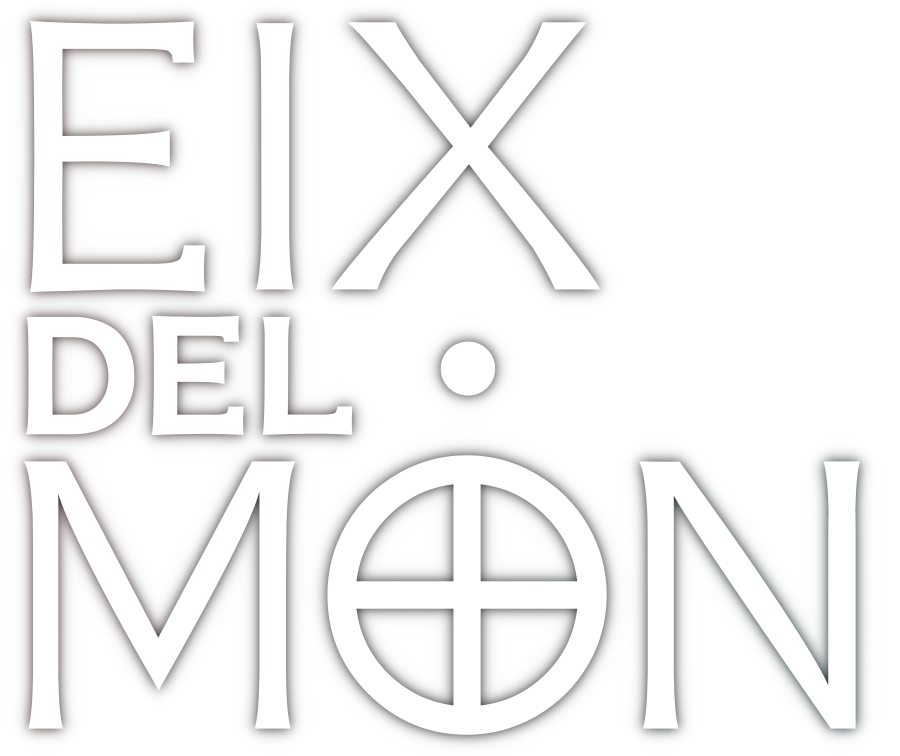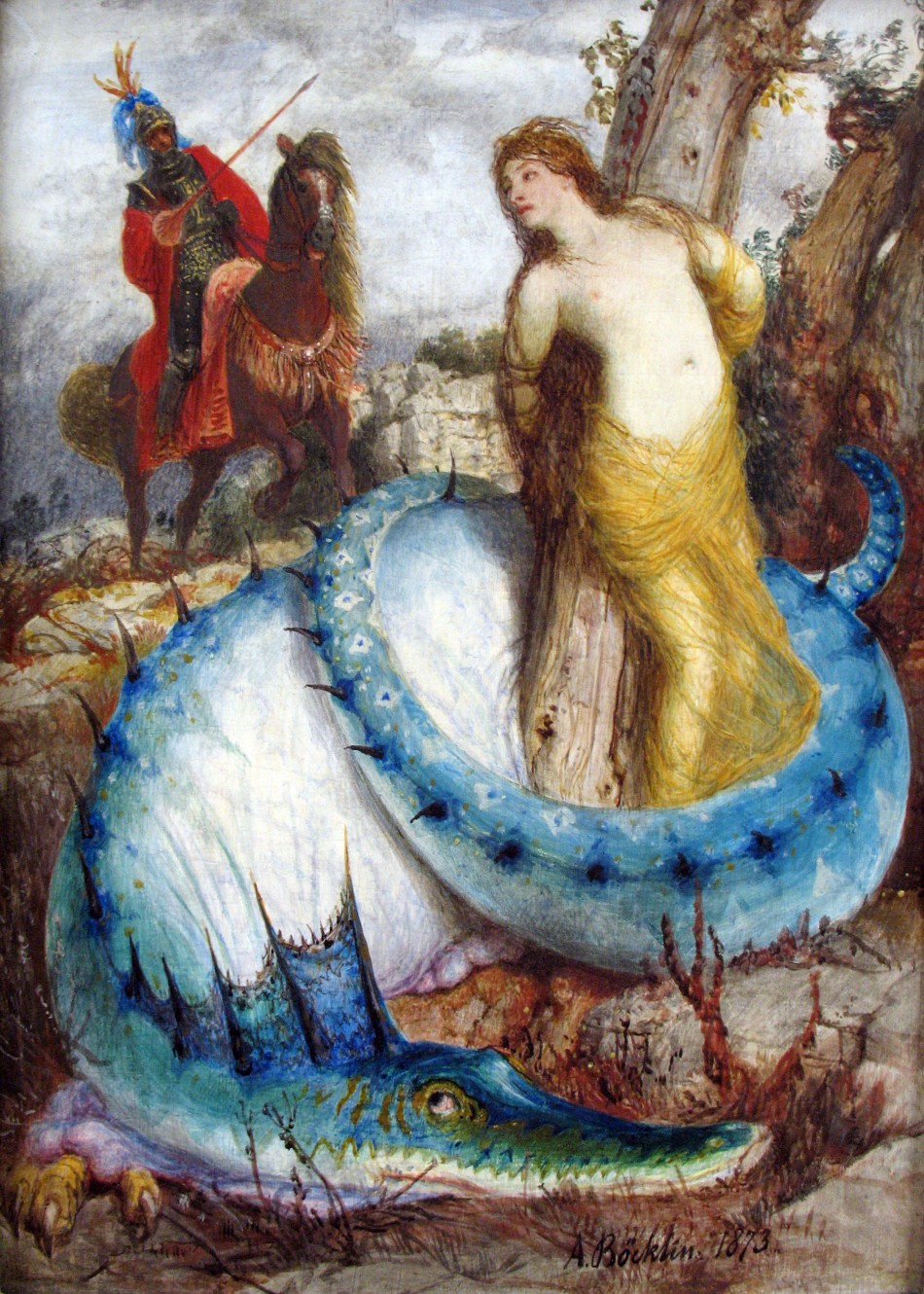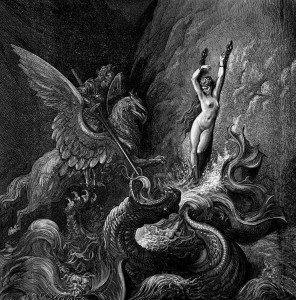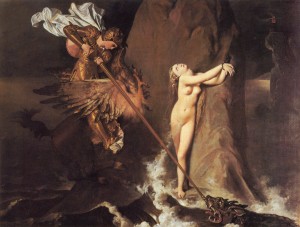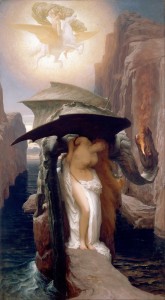Ruggiero and Angelica by Arnold Böcklin. 1873, Tempera on panel, 46 × 37 cm (18.1 × 14.6 in). Alte Nationalgalerie. Reference.
See other depictions from this same scene:
Some extra info. About Angelica:
Angelica is continually sought throughout the world by Orlando, Rinaldo, and the best knights from various countries. She eventually finds herself naked and chained to a rock in the sea, offered as a sacrifice to a sea monster (a situation identical to the perils of Andromeda). She is rescued by the African knight Ruggiero, who gives her a ring of invisibility. Later, pursued by the maddened Orlando, she uses the ring and vanishes.
Ruggiero is riding an hippogriff. The description in the poem is here (canto IV):
-
-
-
- XVIII
-
-
- no fiction wrought magic lore,
- But natural was the steed the wizard pressed;
- For him a filly to griffin bore;
- Hight hippogryph. In wings and beak and crest,
- Formed like his sire, as in the feet before;
- But like the mare, his dam, in all the rest.
- Such on Riphaean hills, though rarely found,
- Are bred, beyond the frozen ocean’s bound.
-
-
-
- XIX
-
-
- Drawn by enchantment from his distant lair,
- The wizard thought but how to tame the foal;
- And, in a month, instructed him to bear
- Saddle and bit, and gallop to the goal;
- And execute on earth or in mid air,
- All shifts of manege, course and caracole;
- He with such labour wrought. This only real,
- Where all the rest was hollow and ideal.
According to Thomas Bulfinch’s Legends of Charlemagne:
Like a griffin, it has the head of an eagle, claws armed with talons, and wings covered with feathers, the rest of its body being that of a horse. This strange animal is called a Hippogriff. the hippogriff is said to be an evil spirit resting and possessing its soul in that of a horse and griffin.
The situation is identical to the perils of Andromeda. Do not miss the illustrated Ovid’s Metamorphoses!
-
![[PDF]](https://www.eixdelmon.com/wp-content/plugins/papercite/img/pdf.png) L. Ariosto, Orlando Furioso, Oxford University Press, 1823.
L. Ariosto, Orlando Furioso, Oxford University Press, 1823.
[Bibtex]@Book{orlandofurioso07ariogoog, author = {Ariosto, Lodovico}, title = {Orlando Furioso}, year = {1823}, publisher = {Oxford University Press}, url = {http://www.archive.org/details/orlandofurioso07ariogoog}, abstract = {https://en.wikipedia.org/wiki/Orlando_Furioso Orlando Furioso (Italian: [orˈlando fuˈrjoːzo; -oːso]; The Frenzy of Orlando, more literally Raging Roland; in Italian furioso is seldom capitalized) is an Italian epic poem by Ludovico Ariosto which has exerted a wide influence on later culture. The earliest version appeared in 1516, although the poem was not published in its complete form until 1532. Orlando Furioso is a continuation of Matteo Maria Boiardo's unfinished romance Orlando Innamorato ("Orlando in Love", published posthumously in 1495). In its historical setting and characters, it shares some features with the Old French Chanson de Roland of the eleventh century, which tells of the death of Roland. Orlando is the Christian knight known in French (and subsequently English) as Roland. The action takes place against the background of the war between Charlemagne's Christian paladins and the Saracen army that has invaded Europe and is attempting to overthrow the Christian empire. The poem is about war and love and the romantic ideal of chivalry. It mixes realism and fantasy, humor and tragedy.[1] The stage is the entire world, plus a trip to the moon. The large cast of characters features Christians and Saracens, soldiers and sorcerers, and fantastic creatures including a gigantic sea monster called the orc and a flying horse called the hippogriff. Many themes are interwoven in its complicated episodic structure, but the most important are the paladin Orlando's unrequited love for the pagan princess Angelica, which drives him mad; the love between the female Christian warrior Bradamante and the Saracen Ruggiero, who are supposed to be the ancestors of Ariosto's patrons, the d'Este family of Ferrara; and the war between Christian and Infidel.[2] The poem is divided into forty-six cantos, each containing a variable number of eight-line stanzas in ottava rima (a rhyme scheme of abababcc). Ottava rima had been used in previous Italian romantic epics, including Luigi Pulci's Morgante and Boiardo's Orlando Innamorato. Ariosto's work is 38,736 lines long in total, making it one of the longest poems in European literature.[3] The action of Orlando Furioso takes place against the background of the war between the Christian emperor Charlemagne and the Saracen King of Africa, Agramante, who has invaded Europe to avenge the death of his father Traiano. Agramante and his allies – who include Marsilio, the King of Spain, and the boastful warrior Rodomonte – besiege Charlemagne in Paris. Meanwhile, Orlando, Charlemagne's most famous paladin, has been tempted to forget his duty to protect the emperor through his love for the pagan princess Angelica. At the beginning of the poem, Angelica escapes from the castle of the Bavarian Duke Namo, and Orlando sets off in pursuit. The two meet with various adventures until Angelica saves a wounded Saracen knight, Medoro, falls in love, and elopes with him to Cathay. When Orlando learns the truth, he goes mad with despair and rampages through Europe and Africa destroying everything in his path. The English knight Astolfo journeys to Ethiopia on the hippogriff to find a cure for Orlando's madness. He flies up in Elijah's flaming chariot to the moon, where everything lost on earth is to be found, including Orlando's wits. He brings them back in a bottle and makes Orlando sniff them, thus restoring him to sanity. (At the same time Orlando falls out of love with Angelica, as the author explains that love is itself a form of insanity.) Orlando joins with Brandimart and Oliver to fight Agramante, Sobrino and Gradasso on the island of Lampedusa. There Orlando kills King Agramante. Another important plotline involves the love between the female Christian warrior Bradamante and the Saracen Ruggiero. They too have to endure many vicissitudes. Ruggiero is taken captive by the sorceress Alcina and has to be freed from her magic island. He also has to avoid the enchantments of his foster father, the wizard Atlante, who does not want him to fight. Finally, Ruggiero converts to Christianity and marries Bradamante. Rodomonte appears at the wedding feast and accuses him of being a traitor to the Saracen cause, and the poem ends with Ruggiero slaying Rodomonte in single combat. Ruggiero and Bradamante are the ancestors of the House of Este, Ariosto's patrons, whose genealogy he gives at length in canto 3 of the poem. The epic contains many other characters, including Orlando's cousin, the paladin Rinaldo, who is also in love with Angelica; the thief Brunello; the Saracen Ferraù; Sacripante, King of Circassia and a leading Saracen knight; and the tragic heroine Isabella.}, comment = {Published 1974 Topics Roland (Legendary character) Identifier orlandofurioso07ariogoog Scanner google Mediatype texts Translator William Stewart Rose Identifier-access http://www.archive.org/details/orlandofurioso07ariogoog Oclc-id 1001886 Scandate 20060130 Copyright-region US Identifier-ark ark:/13960/t72v2jc08 Imagecount 241 Source http://books.google.com/books?id=fDgj4tCoQL0C&oe=UTF-8 Lccn 74174554 Ocr ABBYY FineReader 8.0 SHOW LESS Book digitized by Google from the library of the New York Public Library and uploaded to the Internet Archive by user tpb. Volume 1 Publisher London, New York, Oxford University Press Year 1823 Pages 241 Possible copyright status NOT_IN_COPYRIGHT Language English; Italian Digitizing sponsor Google Book from the collections of New York Public Library Collection americana}, file = {orlandofurioso07ariogoog.pdf:media/trismegisto/Vitamin/Documents/Bibliography/orlandofurioso07ariogoog.pdf:PDF}, keywords = {roland,perseus,andromeda}, timestamp = {2016-07-28}, } -
![[PDF]](https://www.eixdelmon.com/wp-content/plugins/papercite/img/pdf.png) Ovid, The Metamorphoses of Ovid Literally Translated into English Prose, with Copious Notes and Explanations. Books VIII – XV, Project Gutenberg, 1893.
Ovid, The Metamorphoses of Ovid Literally Translated into English Prose, with Copious Notes and Explanations. Books VIII – XV, Project Gutenberg, 1893.
[Bibtex]@Book{themetamorphoses26073gut, author = {Ovid}, title = {The Metamorphoses of Ovid Literally Translated into English Prose, with Copious Notes and Explanations. Books VIII - XV}, year = {1893}, note = {This e-text covers the second half, Books VIII-XV, of Henry T. Riley’s 1851 translation of Ovid’s Metamorphoses. The first half, Books I-VII, is already available from Project Gutenberg as e-text 21765. Note that this text, unlike the earlier one, is based solely on the 1893 George Bell reprint. The text includes characters that will only display in UTF-8 (Unicode) file encoding, including Greek words in the Notes: œ, Œ (oe ligature) κείρω, ἀκονιτὶ If any of these characters do not display properly, or if the apostrophes and quotation marks in this paragraph appear as garbage, you may have an incompatible browser or unavailable fonts. First, make sure that the browser’s “character set” or “file encoding” is set to Unicode (UTF-8). You may also need to change your browser’s default font. All Greek words have mouse-hover transliterations: Δηοῦς κόρη.}, publisher = {Project Gutenberg}, url = {http://archive.org/details/themetamorphoses26073gut}, file = {themetamorphoses26073gut.epub:media/trismegisto/Vitamin/Documents/Bibliography/themetamorphoses26073gut.epub:ePUB}, timestamp = {2016-07-28}, } -
![[PDF]](https://www.eixdelmon.com/wp-content/plugins/papercite/img/pdf.png) Ovid, The Metamorphoses of Ovid Literally Translated into English Prose, with Copious Notes and Explanations. Books I – VII, Project Gutenberg, 1893.
Ovid, The Metamorphoses of Ovid Literally Translated into English Prose, with Copious Notes and Explanations. Books I – VII, Project Gutenberg, 1893.
[Bibtex]@Book{themetamorphoses21765gut, author = {Ovid}, title = {The Metamorphoses of Ovid Literally Translated into English Prose, with Copious Notes and Explanations. Books I - VII}, year = {1893}, note = {This e-text covers the first half, Books I-VII, of Henry T. Riley’s 1851 translation of Ovid’s Metamorphoses. The second half, Books VIII-XV, is already available from Project Gutenberg as e-text 26073. The text includes characters that will only display in UTF-8 (Unicode) file encoding, including Greek words in the Notes: œ, Œ (oe ligature) κείρω, ἀκονιτὶ If any of these characters do not display properly, or if the apostrophes and quotation marks in this paragraph appear as garbage, you may have an incompatible browser or unavailable fonts. First, make sure that the browser’s “character set” or “file encoding” is set to Unicode (UTF-8). You may also need to change your browser’s default font. All Greek words have mouse-hover transliterations: Δηοῦς κόρη.}, publisher = {Project Gutenberg}, url = {http://archive.org/details/themetamorphoses26073gut}, file = {themetamorphoses26073gut.epub:media/trismegisto/Vitamin/Documents/Bibliography/themetamorphoses26073gut.epub:ePUB}, timestamp = {2016-07-28}, } -
![[PDF]](https://www.eixdelmon.com/wp-content/plugins/papercite/img/pdf.png) Ovid, Metamorphoses, Illustrated, Georgium Coruinum, Sigismundum Feyerabent & haeredes Vvigandi Galli, 1563.
Ovid, Metamorphoses, Illustrated, Georgium Coruinum, Sigismundum Feyerabent & haeredes Vvigandi Galli, 1563.
[Bibtex]@Book{ovidmetamorphoses1563, title = {Metamorphoses, Illustrated}, publisher = {Georgium Coruinum, Sigismundum Feyerabent \& haeredes Vvigandi Galli}, year = {1563}, author = {Ovid}, comment = {Published 1563 Usage Attribution-Noncommercial-No Derivative Works 3.0 Topics Ovid, Metamorphoses, German, Edition, 1563, Woodcuts, Virgil Solis, Publisher Feyerabent Identifier OvidMetamorphoses1563 Mediatype texts Licenseurl http://creativecommons.org/licenses/by-nc-nd/3.0/ Scanner Internet Archive HTML5 Uploader 1.5.2 Identifier-access http://archive.org/details/OvidMetamorphoses1563 Identifier-ark ark:/13960/t75t67t8b Ppi 150 Ocr ABBYY FineReader 9.0 1563 Illustrated Edition of Ovid's Metamorphoses Author: Ovid (Publius Ovidius Naso) Title: Metamorphoses Publisher: Georg Corvin, Sigismund Feyerabent & Wigandi Galli (Georgium Coruinum, Sigismundum Feyerabent & haeredes Vvigandi Galli) Poet: Johannes Posthius von Germersheim (old spelling Germersheim) Illustrations: Virgil Solis (Woodcuts) Printed in Frankfurt, Germany 1563. (Impressum Francofurti, MDLXIII) Collection: The Norris Museum, St Ives, Cambridgeshire, UK. Catalogue Numbers 90 and 200. Digitization: By Dr Chris Thomas, on behalf of the Norris Museum Nikon DS5200 Camera with Flash RAW (Nikon NEF) Format 6000pixels x 4000pixels (originals with Norris Museum) Cropped and edited in Corel AfterShot Pro 1.2.0.7 Exported as 1600pixel x 1200pixel images and converted to PDF book Year 1563 Language Latin Collection opensource}, file = {OvidMetamorphoses1563.pdf:media/trismegisto/Vitamin/Documents/Bibliography/OvidMetamorphoses1563.pdf:PDF}, keywords = {Ovid, Metamorphoses, German, Edition, 1563, Woodcuts, Virgil Solis, Publisher Feyerabent}, timestamp = {2016-03-14}, url = {https://archive.org/details/OvidMetamorphoses1563} }
